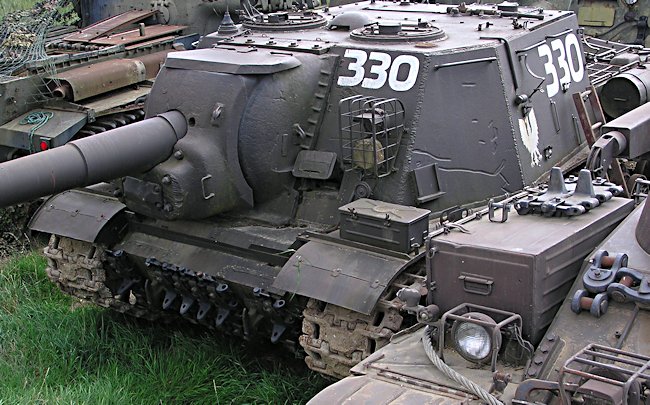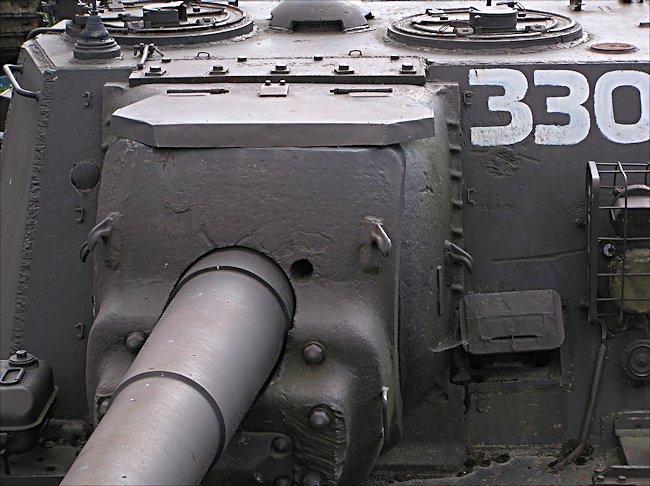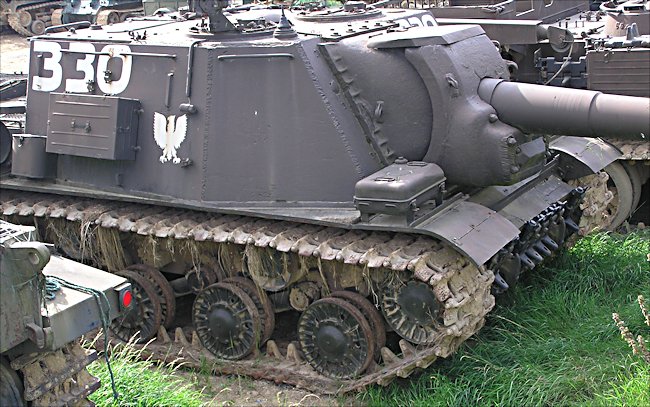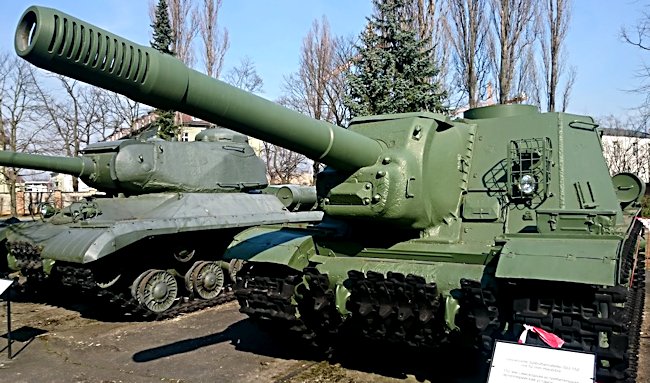Missing ISU-152 SPG
This Russian Soviet ISU 152 Heavy Self Propelled Gun SPG was kept at the Imperial War Museum Duxford, Duxford Airfield, Cambridge but has since been sold to a private collector. Do you know who is looking after it now? E-mail me if you do.

Russian Soviet ISU 152 Heavy Self Propelled Gun SPG in Polish Army markings
Why did the Russians need a ISU-152 Assault Gun?
Around mid-1943 the Soviet army had the assault gun SU-152. It was a mounted ML-20 152mm howitzer-gun fixed on top of a KV-1S tank chassis. It was intended for use against German fortifications like machine gun nests, pillboxes and reinforced buildings. Later, when the Joseph Stalin IS tank chassis became available production of this assault gun shifted to using this tank. It was renamed ISU-152.
The prototype for the ISU-152 was completed in October 1943 and it into production in December of the same year. It had a few differences to its predecessor. There was a different steering mechanism and it had new optics. A new crew compartment ventilation fan help the crew deal with toxic fumes from the engine and gun.More armour was added to the vehicle for greater protection. The SU-152 had only 60mm of armour. The ISU-152 assault gun's armour was upgraded to 90mm of sloping armour at 30°. The two side plates of the cabin were also angled. They were 75mm thick.
You can tell the difference between an early and late production ISU-152. The later versions had a welded bottom front armoured hull underneath the gun. The early versions had a cast armoured chassis. Many of the ISU-152 examples that have survived in museums have been modernised. They were used after World War II by many different armies throughout the world.

Russian Soviet ISU 152 Heavy Self Propelled Gun SPG
Quite often see headlights on the front in a wire cage. These were not present on the World War II vehicles. To the right of the driver's hatch as you look at it from the front vehicle, you will see a circular disc on a stand sitting proud of the front armour. That is the vehicle's horn. On the side and at the rear, there are little red marker lights to help other tanks to see you when driving at night. They look like little table salt shakers.
Above the drivers hatch, there is a small porthole opening. This is where the crew could stick out the muzzle of their own personal rifle or machine gun to shoot at the enemy. There is another one on the other side of the gun. These holes were often welded up on post-war versions.
Spare track links were bolted onto the front underside armour plating by the to tow hooks, the added protection. The ISU-152 had for 90 litre external fuel tanks strapped to announce at the back of the assault gun just like on the T 34 series of tanks. But the difference was these tanks were part of the fuel system and connected to the main fuel tank by pipes. T 34 tank crews had to get out of the tank to fill up the vehicles fuel tank from his external containers. This was a good upgrade. World War II versions of the ISU-152 only had external fuel tanks alongside not at the rear of the vehicle.

Russian Soviet ISU 152 Heavy Self Propelled Gun SPG
The tracked running gear is straight from the IS tank. There are six pairs per side of steel road wheels. Each one had its own independent suspension arm. The track is 650mm wide to help this heavy vehicle cross boggy and snowy conditions found over Russia during winter.
The back of the tank has sloping armour but the plates bolted to assist the removal to get at the engine. The two smaller round hinged hatches were for routine maintenance and access to the transmission. In the centre of the hatch, you will see a black square rubber pad. This is to prevent it causing damage to the hinge when it was opened. If the crew had to do major repair work to the engine hold back panel could be unbolted.
Have a look over the left side third road wheel. You will see a hinged circular hatch. This was the unusual entrance point to load the heavy 152mm rounds. This avoids having to hoist the ammunition up to the turret like on the German Sturmtager. What a clever idea.
It was armed with a 152.4 mm ML-20S (МЛ-20С) gun-howitzer, with a barrel length of over 4.2 metres (27.9 calibers). The ISU-152 could carry 21 rounds to piece shell and charge armour piercing and high explosive HE ammunition. The gun had a maximum range of 6 km, about 4 miles. It was used as a heavy assault gun, heavy tank destroyer and also a heavy self-propelled artillery gun.

ISU-152 SPG at the rear of the Germand-Russian Museum in Berlin-Karlshorst
The engine hatches were heavily armoured and had built in colling vents. This assault gun was designed cold weather. There was an access plug that you could open access the coolant reservoir about too much difficulty. The engine had a multi-cyclone airfield. When the vehicle had the started in extreme cold Russian weather, the engineers had built in a heater into the air filter. Fuel was sprayed in and there was a high voltage spark plug that starts to ignite the incoming air to make it nice and warm to make it easier to start the engine.
The coolant system also had a wick heater of its own. It was powered by the diesel. That heater not only his coolant so that it was not frozen when you tried to stop the engine but it was also the crew compartment heater as well. Combine all these cold weather systems with a compressed air starting system, this was very much a vehicle designed by engineers to survive in cold weather environment, unlike the German tanks.
On top of the armoured rear section of the tank above the engine, the armoured protective concept extended to the oil and fuel filler caps. You had to use a square range and use a lot of unscrewing to remove the armoured cover. The exhausts were on the top of the tank. They deflected left and right over the rear external diesel fuel tanks.
The Soviet High Command urgently required heavy self-propelled artillery guns to defend the bulge at Kursk. In July 1943 it was decided to deploy them in the anti-tank role rather than the assault gun and artillery barrage role which they could equally perform to a devastating level. The ISU-152 gun could penetrate 120mm of thick armour at a range of 1.5 km. During the summer of 1943 it became a Tiger and Panther tank killer. No German tank could resist the ISU-152's destructive power, at that time.
The 76mm calibre gun that was installed in the KV-1 heavy tank and the T34/76 medium tank could only penetrate the Tiger side armour at a distance of 200 m. The Tiger's 88 mm gun could penetrate the front armour of Russian tanks from 1.5 km away. The Tiger tank had met its match. If the Russian 152mm round failed to penetrate German armour. The weight of the 50kg round would normally break a critical mechanical part of the engine thus in mobilising the vehicle.
The concrete piercing round the could be fired from the ISU-152 SPG weighed more than 50kg. It could penetrate the concrete wall thickness of 1m over 1.5 km away.
The ISU-152 could also be used as a self-propelled artillery gun. Thanks to its powerful calibre. It could destroyer approaching reserves of German troops and armoured vehicles behind the main attack formation. It could also be used to suppress the enemy's artillery. Sometimes they were used to produce an artillery barrage, prior to at attack.
Russian tank crews called this new powerful self-propelled gun "Zveroboy" which means animal Hunter because of its successes against the German Tiger and Panther tank. In the second half 1943, the ISU-152 SPG participated battles on all fronts from Leningrad in the North to the Crimea in the South of Russia.
Unlike most tanks the ISU-152 SPG is ideally suited for urban fighting. It's howitzer fire could knock out attacking enemy trench or urban fortification with ease. The heavy armour of the vehicle allowed to approach these locations with confidence. Direct fire from machine guns or enemy sniper rifles did not affect its unlike the crews of regular towed artillery. ISU-152 self-propelled guns participated in the final operations of capturing Berlin.
Where can I see more ISU-152 Tank Destoyers?
- Association de Sauvegarde du Patrimoine Historique Militaire. 1 Rue Georges Cuvier, La Watzenau, France
- German-Russian (Deutsch-Russisches) Museum Berlin-Karlshorst, Zwieseler Strasse 4
- Bastogne Barracks, Bastogne, Belgium
- ASPHM Association, La Wantzenau, France
- Finnish Armour Museum, Parola, Finland
- Polish Army Museum, Fort IX Czerniakowski, Warsaw, Poland
- Armoured Weapons Museum, Land Forces Training Centre, Poznan, Poland
- Muzeum Oreza Polskiego w Kołobrzegu, Kolobrzeg, Poland
- Muzeum Historyczne, Dukla, Poland
- Museum of Military Techniques, Żukowo, Poland
- Army Technical Museum, Lesany, Czech Republic
- Auto-Retro Museum, Svente, Latvia
- Great Patriotic War Museum, Minsk, Belarus
- Hrodna, Hrodna Voblast, Belarus
- Brest Fortress, Brest, Brest Voblast, Belarus
- Mishnevichi, Vitebsk Voblast, Belarus
- Glory Hill Memorial, near Minsk, Minsk Voblast, Belarus
- Stalin Line Museum, Zaslavl, Minsk Voblast, Belarus
- Gomel Museum of Military Glory, Gomel, Homiel Voblast, Belarus
- Loev, Homiel Voblast, Belarus
- 2x Museum of the Great Patriotic War, Kiev, Ukraine
- Shevchenkivs'kyi district, Kiev, Ukraine
- Regional Museum of Ukrainian Army and Military Equipment, Lutsk, Volyn Oblast, Ukraine
- Rivne, Rivne Oblast, Ukraine
- Kostopil, Rivne Oblast, Ukraine
- Ostropol', Khmelnytsky Oblast, Ukraine
- Iziaslav, Khmelnytsky Oblast, Ukraine
- Starokonstantinov, Khmelnytsky Oblast, Ukraine
- Fridrikhovka, Khmelnytsky Oblast, Ukraine
- Gritsiv, Khmelnytsky Oblast, Ukraine
- Berdychiv, Zhytomyr Oblast, Ukraine
- Vakulenchuk, Zhytomyr Oblast, Ukraine
- Korosten, Zhytomyr Oblast, Ukraine
- Chudniv, Zhytomyr Oblast, Ukraine
- Korosten', Zhytomyr Oblast, Ukraine
- Yampol, Vinnytsia Oblast, Ukraine
- Vakhnivka, Vinnytsia Oblast, Ukraine
- Ulanov, Vinnytsia Oblast, Ukraine
- Mogilіvka, Vinnytsia Oblast, Ukraine
- Perejaslav-Khmelnitskiy, Kiev Oblast, Ukraine
- Kozatske, Cherkasy Oblast, Ukraine
- Ivakhny, near Tsybuliv, Cherkasy Oblast, Ukraine
- Chernigov, Chernihiv Oblast, Ukraine
- Kozelets, Chernihiv Oblast, Ukraine
- Dmitrovka, Chernihiv Oblast, Ukraine
- Novgorod-Severskiy, Chernihiv Oblast, Ukraine
- Velikaya Kokhnovka, Poltava Oblast, Ukraine
- Komsomolsk, Poltava Oblast, Ukraine
- Talnoe, Cherkasy Oblast, Ukraine
- Ivakhny, Cherkasy Oblast, Ukraine
- Khashchuvate, near Haivoron, Kirovohrad Oblast, Ukraine
- Zolochiv, Kharkiv Oblast, Ukraine
- Lozova, Kharkiv Oblast, Ukraine
- Izium, Kharkiv Oblast, Ukraine
- Танаnс historical association, Ukraine
- Yad la-Shiryon Museum, Latrun, Israel
- Victory Park at Poklonnaya Gora, Moscow, Russia
- Central Armed Forces Museum, Moscow, Russia
- 3x Kubinka Tank Museum, Russia
- Military Historical Museum, Lenino-Snegiri, Russia
- State Military Technical Museum, Ivanovskoje, Moscow Oblast, Russia
- Military Historical Museum of Artillery, Engineer and Signal Corps, St.-Petersburg, Russia
- Monument at Priozersk, Leningrad Oblast, Russia
- Museum of Military Air Forces of the Northern Fleet, Safonovo, Murmansk Oblast, Russia
- Mglin, Bryansk Oblast, Russia
- Kursk, Kurst Oblast, Russia
- Soskovo, Oryol Oblast, Russia
- Vadim Zadorozhny Museum, Arhangelskoe, Moscow Oblast, Russia
- Museum of the National Military History, Padikovo, Moscow Oblast, Russia
- Skirmanovo, Moscow Oblast, Russia
- Naro-Fominsk, Moscow Oblast, Russia
- Kalininets, Moscow Oblast, Russia
- Krasnoarmeysk, Moscow Oblast, Russia
- Rybinsk, Yaroslavl Oblast, Russia
- Rushej, Vladimir Oblast, Russia
- Kineshma, Ivanovo Oblast, Russia
- Nizhny Novgorod, Nizhny Novgorod Oblast, Russia
- Mylino, Nizhny Novgorod Oblast, Russia
- Kovernino, Nizhny Novgorod Oblast, Russia
- Belgorod State Historical and Art Museum-Diorama, Kursk Battle,Belgorod, Belgorod Oblast, Russia
- Prokhorovka, Belgorod Oblast, Russia
- Alexeyevka, Belgorod Oblast, Russia
- Novyy Oskol, Belgorod Oblast, Russia
- Museum-diorama Defense of Voronezh, Voronezh, Voronezh Oblast, Russia
- Puhovo, Voronezh Oblast, Russia
- Kamenka, Lipetsk Oblast, Russia
- Volovo, Lipetsk Oblast, Russia
- 2x Krasnodar, Krasnodar Krai, Russia
- Sapun Gora, Sevastopol, Crimean Peninsula, Russia
- Shchemilovka, Crimean Peninsula, Russia
- Panoramic Museum Stalingrad Battle, Volgograd, Russia
- Sokolova Gora, Saratov, Saratov Oblast, Russia
- Ulyanovsk, Ulyanovsk Oblast, Russia
- Mamadysh, Republic of Tatarstan, Russia
- Victory Park, Tolyatti, Samara Oblast, Russia
- Technical museum, Tolyatti, Samara Oblast, Russia
- Kazan, Republic of Tatarstan, Russia
- Military WW2 Museum Salute,Victory, Orenburg, Orenburg Oblas, Russia
- Syktyvkar, Komi Republic, Russia
- Museum of JSC Motoviliha, Perm, Perm Krai, Russia
- Kyeda, Perm Krai, Russia
- Chaykovsky, Perm Krai, Russia
- Chusovoy, Perm Krai, Russia
- Oktyabrsky, Perm Krai, Russia
- Yubileyny, Perm Krai, Russia
- Victory Garden, Chelyabinsk, Chelyabinsk Oblast, Russia
- Chelyabinsk Tractor Factory, Chelyabinsk Oblast, Russia
- Elektromashina Factory, Chelyabinsk, Chelyabinsk Oblast, Russia
- Orlenok Center, Snezhinsk, Chelyabinsk Oblast, Russia
- Chelyabinsk area, Chelyabinsk Oblast, Russia
- Chebakul, Chelyabinsk Oblast, Russia
- 2x Museum of military equipment Battle Glory of the Urals, Verkhnyaya, Pyshma, Sverdlovsk Oblast, Russia
- Yekaterinburg, Sverdlovsk Oblast, Russia
- Irbit, Sverdlovsk Oblast, Russia
- Neviansk, Sverdlovsk Oblast, Russia
- Omsk Battle Glory Museum, Omsk, Omsk Oblast, Russia
- Ust-Ishimsk, Omsk Oblas, Russia
- Novosibirsk, Novosibirsk Oblast, Russia
- Khabarovsk, Khabarovsk Kraï, Russia
- Military area, Almaty Province, Kazakhstan
- Tank School, Chirchik, Uzbekistan
- 3x The Tank Museum, Beijing (China
- Source - Pierre-Oliver Buan - http://the.shadock.free.fr/Surviving_Panzers.html
WW2 tank books

